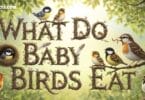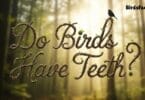
Complete Guide to Identifying Yellow and Black Birds
Have You Ever Been Out In Your Backyard Or On A Walk And Spotted A Striking Bird With Bright Yellow And Bold Black Feathers But Had No Idea What It Was You Are Not Alone Many Bird Lovers And Even Casual Observers Find Themselves Curious And A Little Frustrated When They Can Not Put A Name To The Beautiful Yellow And Black Birds They See.
The Good News Is These Eye Catching Birds Are Easier To Identify Than You Might Think From Tiny Warblers To Larger Orioles Yellow And Black Birds Are Not Only Gorgeous But Also Fascinating To Learn About. In This Post We Will Explore Some Of The Most Common Species Where You Can Find Them And A Few Simple Tips To Help You Recognize Different Yellow And Black Birds The Next Time One Flies By.
Yellow and Black Birds
- American Goldfinch
- Common Yellowthroat
- Eastern Meadowlark
- Evening Grosbeak
- Hooded Warbler
- Lesser Goldfinch
- Magnolia Warbler
- Prothonotary Warbler
- Scott’s Oriole
- Western Meadowlark
- Western Tanager
- Wilson’s Warbler
- Yellow-headed Blackbird
American Goldfinch

American Goldfinch Perched On Branch Showing Bright Yellow Black Wing Feathers.
The American Goldfinch Is One Of The Brightest Songbirds In North America Males In Summer Wear A Dazzling Lemon Yellow Coat With Jet Black Wings And Cap Making Them Hard To Miss And They Are Often Classified Among Yellow And Black Birds Because Of Their Striking Colors. Females And Winter Males Are Duller But They Still Show Hints Of Yellow And The Same Pointed Bill Their Bouncy Undulating Flight Makes Them Easy To Recognize As They Dart Over Fields Or Flutter To Backyard Feeders.
You Will Often See Goldfinches Around Weedy Fields Gardens And Feeders Stocked With Thistle Seed They Are Frequent Visitors To Backyards Especially If You Provide The Right Food And Habitat. Their Cheerful Canary Like Song Adds A Musical Backdrop To Summer Mornings And Their Sight Alongside Other Yellow And Black Birds Is Always A Delight For Bird Lovers. For Birdwatchers They Are A Great First Species To Identify And If You Are Into Bird Photography Tips These Birds Are Perfect Subjects Thanks To Their Brilliant Contrast With Other Yellow And Black Birds In The Wild.
| Feature | Detail |
|---|---|
| Plumage | Bright Yellow Body With Black Wings And Cap |
| Behavior | Distinctive Bouncy Flight Pattern |
| Habitat | Common At Bird Feeders And Weedy Fields |
| Call | Cheerful Song Often Given In Flight |
Common Yellowthroat

Common Yellowthroat Perched On Reed Showing Bright Yellow Throat And Mask.
The Common Yellowthroat Is A Small Warbler With A Big Personality Males Sport A Bright Yellow Throat And Chest Paired With A Bold Black Mask That Gives Them A Bandit Like Look And This Appearance Places Them Among Yellow And Black Birds Often Admired By Bird Lovers. Females Lack The Mask But Share The Warm Yellow Coloring That Makes Them Stand Out In Dense Vegetation Their Call A Sharp Wichity Wichity Wichity Is One Of The Easiest Ways To Detect Them.
Unlike Goldfinches These Warblers Prefer Wetlands Marshes And Shrubby Edges They Skulk Low In Thick Cover Making Them A Bit Trickier To Spot But Their Consistent Song Gives Them Away. If You Are Interested In Birdwatching Tips For Beginners Listening Carefully Can Be Just As Useful As Looking. Identifying Birds By Sound Is An Essential Skill And The Common Yellowthroat Along With Other Yellow And Black Birds Is A Perfect Species To Practice With And Observing Different Yellow And Black Birds Together Can Be An Exciting Learning Experience.
| Feature | Detail |
|---|---|
| Plumage | Small Warbler With Bright Yellow Throat And Chest |
| Markings | Males Feature A Bold Black Face Mask |
| Habitat | Found In Wetlands / Cattails / Shrubby Edges |
Eastern Meadowlark
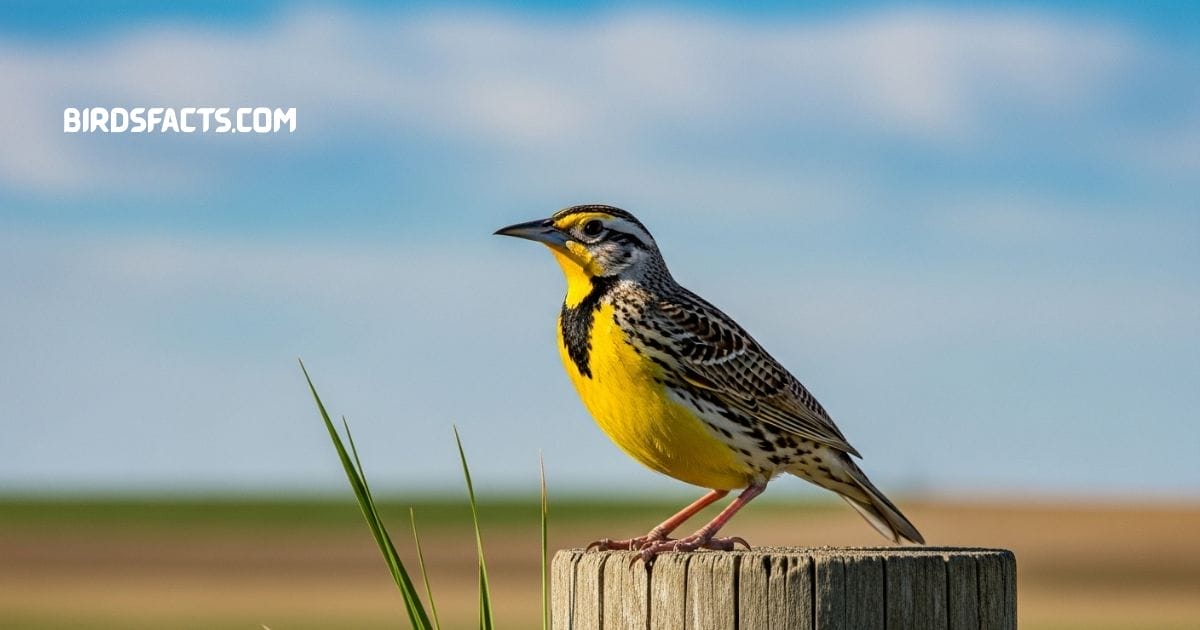
Eastern Meadowlark Standing On Grass Showing Bright Yellow Chest And Markings.
Eastern Meadowlarks Bring Music To Open Fields With Their Flute Like Songs They Have A Bright Yellow Chest Marked By A Bold Black V Across It While Their Backs Are Streaked Brown Helping Them Blend Into Grassy Surroundings And They Are Often Counted Among Yellow And Black Birds Because Of Their Distinctive Appearance. When Perched On A Fencepost Or Singing From A Tall Stem Their Yellow Seems To Glow Against The Prairie Landscape.
These Birds Thrive In Grasslands Meadows And Agricultural Fields They Are Ground Nesters Which Means Conserving Large Open Spaces Is Key To Their Survival. If You Enjoy Prairie Bird Songs The Eastern Meadowlarks Clear Whistles Are Unforgettable And Their Presence Alongside Other Yellow And Black Birds Adds To The Beauty Of Open Country. Watching One Sing Can Feel Like Stepping Into A Living Postcard Of Rural America And Observing Multiple Yellow And Black Birds Together Creates An Even More Magical Experience.
| Feature | Detail |
|---|---|
| Plumage | Yellow Chest With Distinctive Black V Marking |
| Song | Flute Like Melodic Whistles |
| Habitat | Ground Nester Found In Grasslands And Farmlands |
Evening Grosbeak
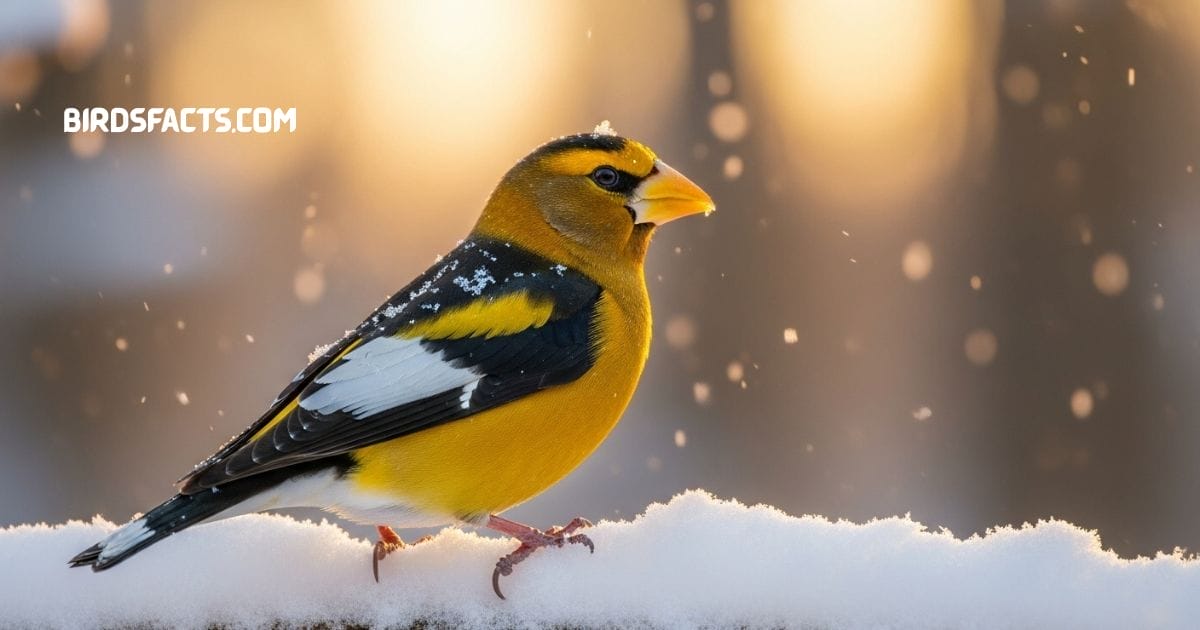
Evening Grosbeak Perched On Branch Showing Yellow Black Wings And Beak.
The Evening Grosbeak Is A Chunky Powerful Finch With A Thick Beak Made For Cracking Seeds Males Are Striking With A Mix Of Golden Yellow Bodies Black Wings With Bold White Patches And Dark Heads And They Are Often Grouped Among Yellow And Black Birds Because Of Their Vivid Plumage. Females Are Subtler In Tone But Still Show Hints Of Yellow Along With Gray And White Their Size Alone Makes Them Stand Out Among Other Backyard Birds.
You Are More Likely To See Evening Grosbeaks At Feeders During Winter When Natural Food Is Scarce They Move In Flocks And Can Quickly Empty Seed Trays Especially If Sunflower Seeds Are Offered. For Backyard Birders Spotting These Grosbeaks Feels Like Winning A Birding Jackpot And Their Appearance Alongside Other Yellow And Black Birds Brings Extra Excitement. They Are Also A Reminder Of How Bird Populations Shift With The Seasons And Observing Different Yellow And Black Birds Together Highlights The Constant Changes In Nature.
| Feature | Detail |
|---|---|
| Plumage | Bright Yellow With Black Wings And White Wing Patches |
| Bill | Thick Heavy Seed Cracking Bill |
| Habitat | Often Found In Northern Forests And Winter Flocks |
Hooded Warbler
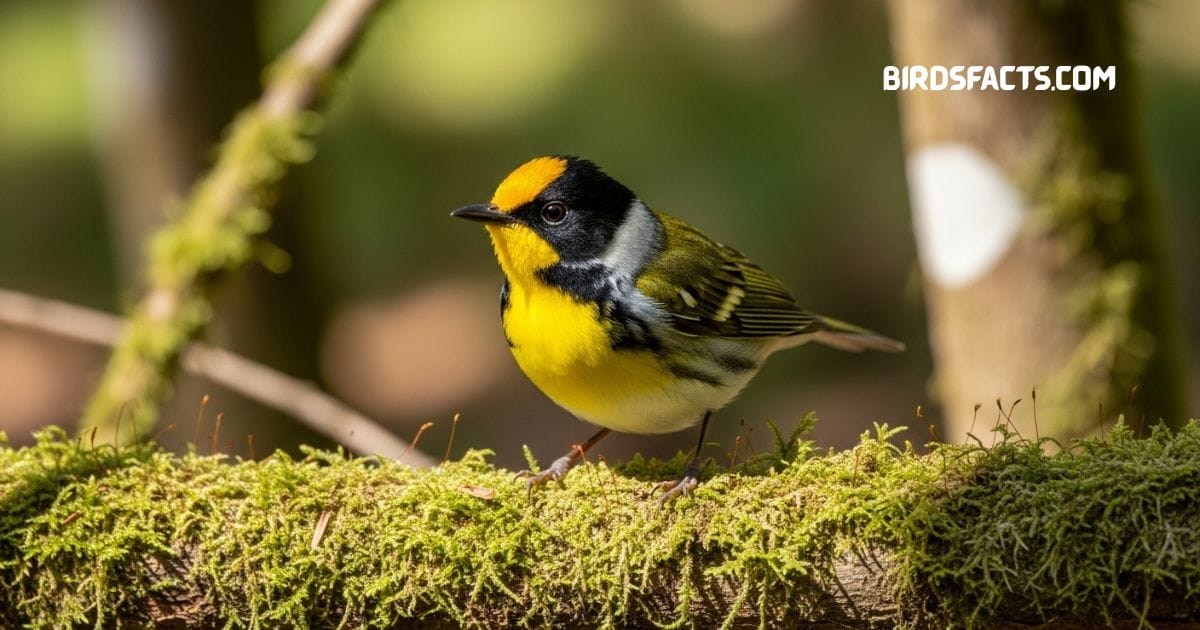
Hooded Warbler Perched On Branch Showing Bright Yellow Body And Black Hood.
The Hooded Warbler Looks Like It Is Wearing A Little Black Hoodie Making It One Of The Easiest Warblers To Identify Males Have A Bright Yellow Face And Underparts Framed By A Striking Black Hood And They Are Often Grouped With Other Yellow And Black Birds Because Of This Distinctive Appearance. Females Are More Subdued With Only Hints Of The Hood Their Small Active Bodies Dart Through Forest Understories Often Flicking Their Tails To Flash White Outer Feathers.
You Will Most Often Encounter Hooded Warblers In Moist Forests Especially In The Eastern United States During Spring And Summer Their Song Is A Cheerful Ringing Series Of Whistles Perfect For Tuning Your Ear During Migration Season. If You Are Learning How To Identify Birds By Color And Sound The Hooded Warblers Bold Markings And Distinctive Voice Make It A Wonderful Teacher And Their Presence Alongside Other Yellow And Black Birds Adds To The Experience. For Birdwatchers Observing Different Yellow And Black Birds Together With The Hooded Warbler Becomes A Highlight Of Any Forest Walk.
| Feature | Detail |
|---|---|
| Plumage | Bright Yellow Face With Black Hood |
| Habitat | Found In Shady Understory Of Eastern Forests |
| Song | Rapid Cheerful Song Distinguishes Them |
Lesser Goldfinch
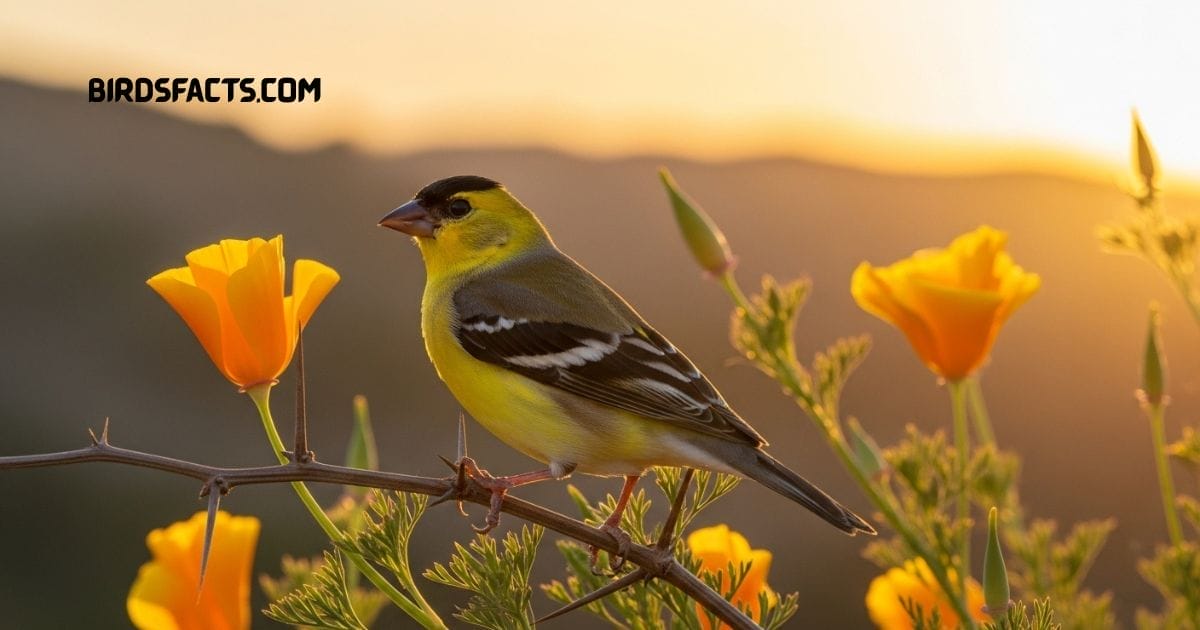
Lesser Goldfinch Perched On Branch Showing Yellow Body And Black Cap.
The Lesser Goldfinch Is The American Goldfinch’s Smaller Cousin Common In The Western And South Western States. Males Sport A Vivid Yellow Belly With Glossy Black Backs And Caps While Females Show More Muted Olive Tones. One Fascinating Feature Is How Much Their Backs Vary In Color Some Populations Are Solid Black While Others Appear Greenish.
These Finches Love Weedy Fields Brushy Areas And Suburban Yards Where Feeders Provide Sunflower Or Thistle Seeds. They Often Gather In Lively Flocks Filling The Air With Constant Chatter And Movement. If You’re Setting Up Bird Feeders For Goldfinches And Orioles You Might Just Attract These Little Dynamos Too. Their Playful Behavior Makes Them A Delight For Backyard Birders And Photographers Alike.
| Feature | Detail |
|---|---|
| Plumage | Small Finch With Black Cap And Yellow Underparts |
| Behavior | Social Often Found In Flocks At Feeders |
| Range | Extends Across Western United States Into Mexico |
Magnolia Warbler

Magnolia Warbler Perched On Branch Showing Yellow Chest And Black Streaks.
The Magnolia Warbler Is A Small But Dazzling Warbler Known For Its Bold Black Streaks On A Bright Yellow Chest Males In Breeding Plumage Are Especially Striking With Black Masks And White Wing Bars And They Are Often Counted Among Yellow And Black Birds Because Of Their Distinctive Plumage. Females And Nonbreeding Birds Show Softer Colors But They Still Carry That Splash Of Yellow That Helps With Identification Despite The Name They Are Not Tied To Magnolia Trees Though One Was First Described There.
This Warbler Is Mostly Seen During Migration Traveling Through The Eastern United States On Its Way Between Canada And Central America Bird Watchers Look Forward To Spring And Fall When Migrating Warblers Bring Sudden Bursts Of Color To Parks And Forests. Spotting A Magnolia Warbler Feels Like Discovering A Moving Jewel Among The Leaves And Their Presence Alongside Other Yellow And Black Birds Creates A More Vivid Scene. For Enthusiasts Observing Multiple Yellow And Black Birds Together With The Magnolia Warbler Becomes An Unforgett Able Highlight Of Bird Watching.
| Feature | Detail |
|---|---|
| Plumage | Yellow Chest With Bold Black Streak Necklace |
| Habitat | Forages In Mid To Upper Canopy |
| Migration | Long Distance Migrant Between North America And Tropics |
Prothonotary Warbler
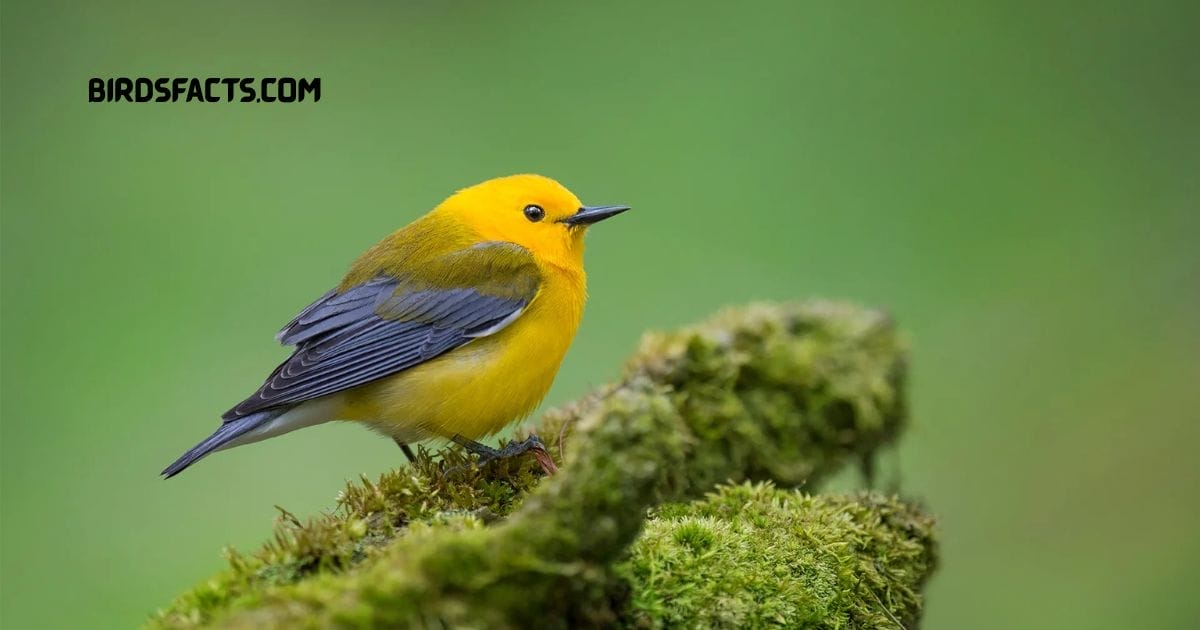
Prothonotary Warbler Perched On Branch Showing Bright Yellow Body And Blue Wings.
The Prothonotary Warbler Shines With Golden Yellow Plumage That Seems To Light Up Swampy Woods And Wetlands Males Are Almost Glowing Yellow From Head To Belly With Contrasting Blue Gray Wings And They Are Often Admired Alongside Other Yellow And Black Birds Because Of Their Brilliant Colors. Females Share The Same Sunny Hue Though In Slightly Duller Shades Their Appearance Has Earned Them The Nickname Swamp Canary.
These Birds Prefer Flooded Forests Riversides And Cypress Swamps Where They Nest In Tree Cavities Near Water Their High Pitched Song Carries Across Wetlands Alerting Birders To Their Presence Even When They Are Hidden. If You Enjoy Birdwatching In Spring Migration The Prothonotary Warbler Is A Real Prize To Spot And Its Presence Along With Other Yellow And Black Birds Adds To The Excitement Of The Season. For Nature Enthusiasts Observing Multiple Yellow And Black Birds Together With The Prothonotary Warbler Highlights The Importance Of Conserving Wetland Habitats For Vibrant Songbirds.
| Feature | Detail |
|---|---|
| Plumage | Bright Golden Yellow Plumage |
| Habitat | Found In Swampy Wetlands And Flooded Forests |
| Song | Loud Ringing Sweet Sweet Sweet Song |
Scott’s Oriole
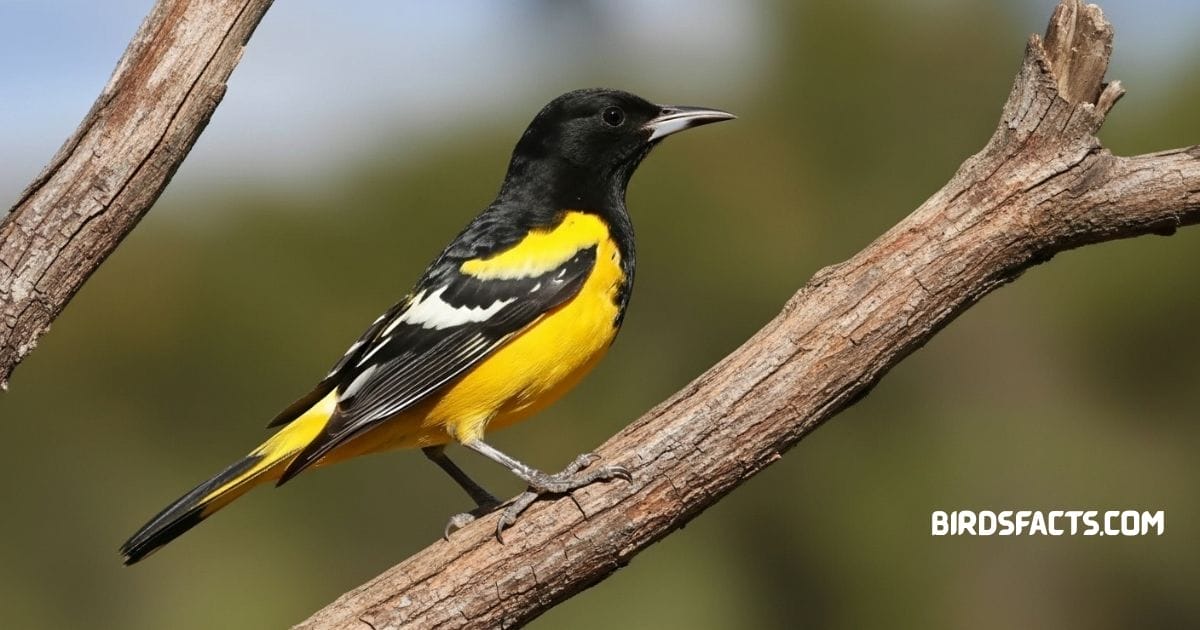
Scotts Oriole Perched On Branch Showing Bright Yellow Body And Black Head.
Scotts Oriole Is A Showstopper Of The Southwest With A Stunning Mix Of Lemon Yellow Underparts And Jet Black Head Back And Wings The Contrast Is Dramatic Making It One Of The Most Recognizable Orioles In North America And It Is Often Counted Among Yellow And Black Birds Because Of Its Striking Plumage. Females Are Paler With Olive Backs But They Still Show Plenty Of Yellow.
These Orioles Live In Deserts And Arid Habitats Often Near Yucca Plants Where They Weave Nests From Fibers They Feed On Insects Fruit And Nectar And Will Also Visit Hummingbird Feeders In Backyards. If You Are Interested In Types Of Orioles In North America Scotts Oriole Stands Out Both For Its Range And Its Striking Colors And Observing It Alongside Other Yellow And Black Birds Adds To The Experience. For Birdwatchers Spotting Different Yellow And Black Birds Together With Scotts Oriole Creates A Memorable Highlight Of Birding In The Southwest.
| Feature | Detail |
|---|---|
| Plumage | Bright Yellow Belly With Black Head And Back |
| Habitat | Found In Desert Foothills With Yuccas And Agaves |
| Song | Strong Flute Like Song |
Western Meadowlark
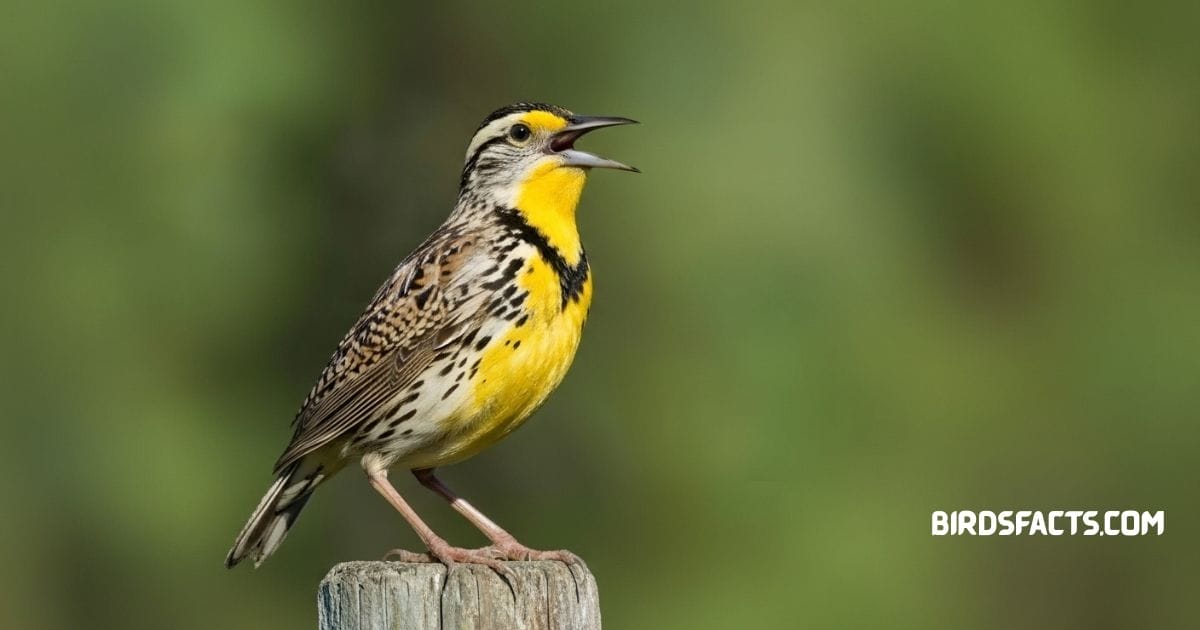
Western Meadowlark Standing On Grass Showing Bright Yellow Chest With Black Markings.
The Western Meadowlark Is Another Grassland Songster And It Is Actually The State Bird Of Six United States Its Yellow Chest And Belly Are Crossed By A Bold Black V While Its Back Is Patterned In Browns That Help It Blend Into Tall Grasses And It Is Often Placed Among Yellow And Black Birds Because Of Its Distinctive Markings. Compared To The Eastern Meadowlark The Western Song Is More Flute Like Often Described As A Liquid Bubbling Melody Their Cheerful Notes Are A Symbol Of Open Prairies.
You Will Usually Find Them Perched On Fenceposts Singing Loudly Over Wide Fields Or Agricultural Land Like Their Eastern Cousins They Nest On The Ground So They Rely On Large Tracts Of Undisturbed Grassland. For Birdwatchers Identifying Meadowlarks Can Be Tricky Without Listening Since Eastern And Western Look Similar And Their Presence Alongside Other Yellow And Black Birds Adds To The Challenge. Paying Attention To Song Is One Of The Best Birdwatching Tips For Beginners And Observing Different Yellow And Black Birds Together With The Western Meadowlark Creates A Memorable Grassland Experience.
| Feature | Detail |
|---|---|
| Plumage | Yellow Chest With Bold Black V |
| Song | Rich Flute Like Song More Complex Than Eastern Meadowlark |
| Status | State Bird Of Six United States States |
Western Tanager

Western Tanager Perched On Branch Showing Bright Yellow Body And Red Head.
The Western Tanager Is A Burst Of Color That Looks Painted By Hand Males Boast A Fiery Red Head Bright Yellow Body And Black Wings Making Them One Of The Most Vibrant Tanager Species In North America And They Are Often Counted Among Yellow And Black Birds Because Of Their Striking Plumage. Females Are Greener With Touches Of Yellow But Still Stand Out Among Conifers These Birds Are Often More Heard Than Seen As They Stay High In Tall Trees.
They Feed On Insects Berries And Occasionally Nectar And Sometimes Visit Backyard Feeders In The Western United States If You Are Comparing Warblers Versus Goldfinches The Western Tanager Is An Entirely Different Family But Shares The Same Eye Catching Brilliance And Their Presence With Other Yellow And Black Birds Adds To The Color Ful Diversity. Spotting One During Spring Migration Feels Like Catching Sight Of A Flying Flame And For Bird Photography Enthusiasts Observing Multiple Yellow And Black Birds Together In Pine Forests Creates A Truly Stunning Scene.
| Feature | Detail |
|---|---|
| Plumage | Red Head Yellow Body Black Wings With White Bars |
| Habitat | Breeds In Coniferous Forests Of Western North America |
| Song | Resembles A Robin But Harsher |
Wilson’s Warbler
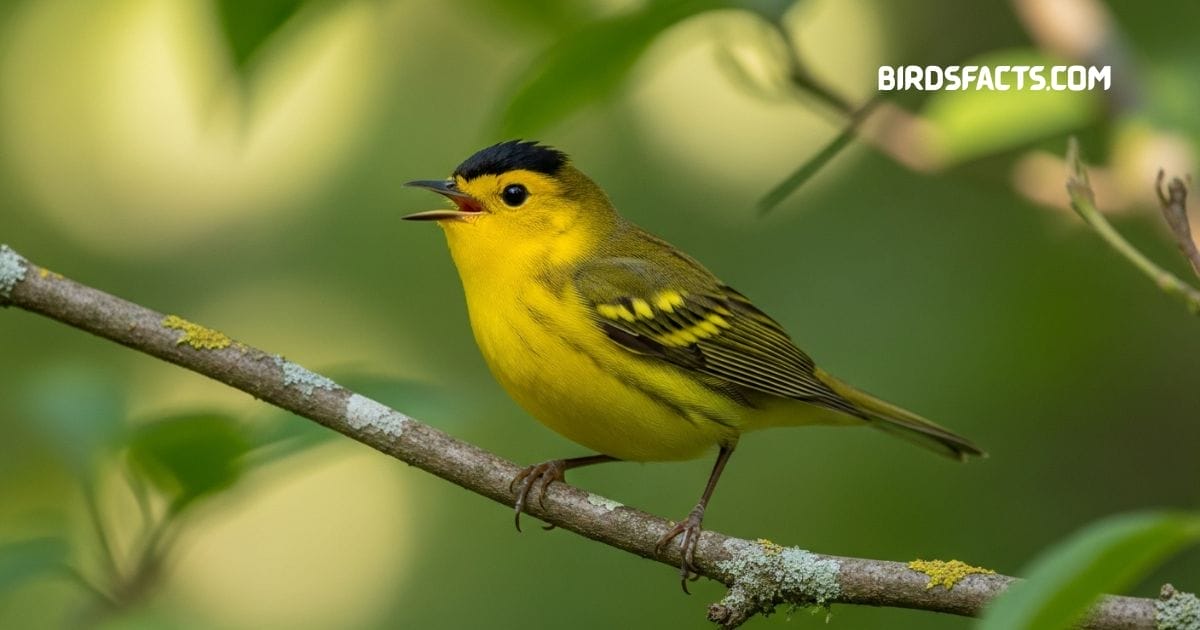
Wilsons Warbler Perched On Branch Showing Bright Yellow Body And Black Cap.
Wilsons Warbler Is A Tiny Energetic Bird With A Simple But Distinctive Look Males Wear A Bright Yellow Body Topped With A Neat Black Cap Almost Like A Miniature Beanie And They Are Often Grouped Among Yellow And Black Birds Because Of Their Markings. Females And Young Birds Lack The Full Cap But Still Shine With Plenty Of Yellow Their Small Size And Constant Movement Make Them Delightful But Sometimes Tricky To Photograph.
These Warblers Thrive In Willows Shrubs And Streamside Thickets Especially During Migration They Are Among The Small Yellow Bird Species That Move Quickly Through Branches Often Giving Soft Chip Calls. If You Are Learning How To Identify Birds By Color Wilsons Warbler Is A Good Reminder That Size And Behavior Matter Just As Much As Plumage And Their Presence Along With Other Yellow And Black Birds Adds To The Experience. For Enthusiasts Spotting Different Yellow And Black Birds Together With Wilsons Warbler Becomes A Special Highlight Of Spring Walks Near Water.
| Feature | Detail |
|---|---|
| Plumage | Tiny Warbler With Bright Yellow Body |
| Markings | Males Have A Small Black Crown |
| Behavior | Energetic Fast Moving Often In Thickets |
Yellow-headed Blackbird
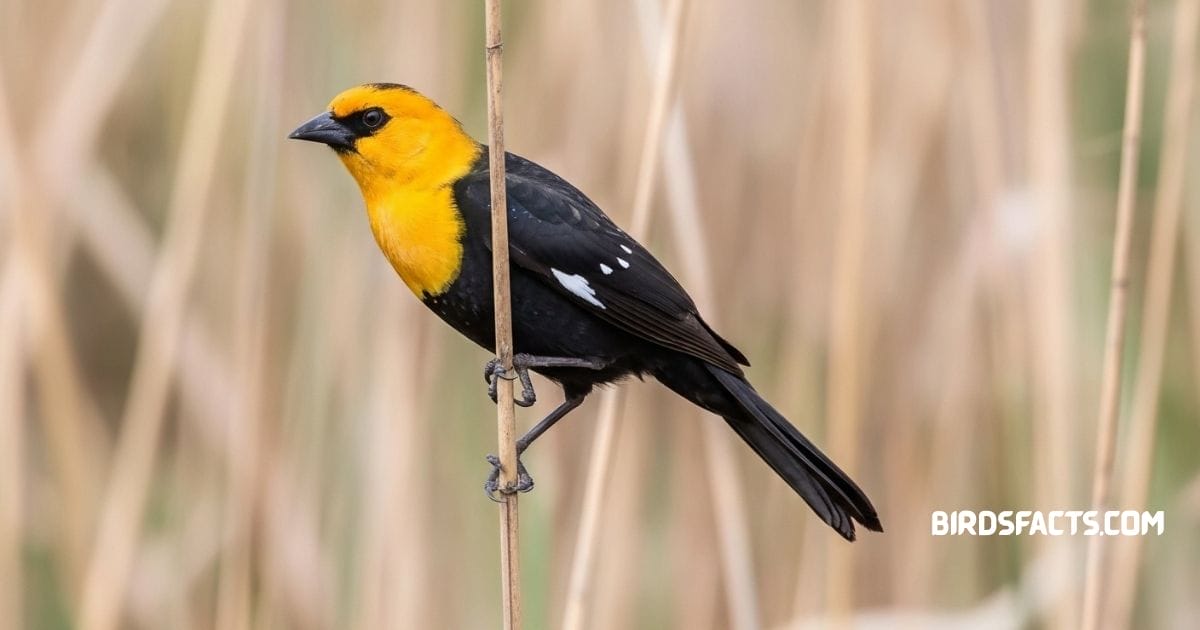
Yellow Headed Blackbird Perched On Reed Showing Bright Yellow Head And Black Body.
The Yellow Headed Blackbird Is A Bold Unmistakable Species Of Wetlands And Marshes Males Feature A Striking Golden Yellow Head And Chest Set Against A Jet Black Body Creating One Of The Most Dramatic Contrasts In The Bird World And They Are Often Considered One Of The Best Examples Of Yellow And Black Birds In North America. Females Are Browner With Less Intense Yellow But Still Carry The Same Overall Pattern Seeing A Flock Of Them Perched On Cattails Is A Memorable Sight.
These Birds Are Tied To Wetlands In The Western And Central United States Where They Nest Among Reeds Their Calls Are Harsh Creaky Sounds More Mechanical Than Musical But They Are Unforgettable Once Heard. If You Are Exploring Yellow And Black Birds This Species Is The Perfect Example Of The Color Combination In Its Boldest Form And Observing Them Alongside Other Yellow And Black Birds Creates An Even More Striking Display. They Also Remind Us That Not All Bird Songs Are Sweet Some Are Wonderfully Strange.
| Feature | Detail |
|---|---|
| Plumage | Golden Yellow Head And Chest With Black Body |
| Call | Harsh Croaking Call |
| Habitat | Breeds In Cattail Marshes And Wetlands |
Frequently Asked Questions(FAQs)
What Birds Are Yellow And Black In North America?
Common Species Include The American Goldfinch Yellow-headed Blackbird Western Meadowlark And Several Warblers Like The Hooded And Wilson’s Warbler.
How Can I Attract Yellow And Black Birds To My Yard?
Offer Thistle Or Sunflower Seeds For Finches Nectar Feeders For Orioles And Maintain Shrubs Or Native Plants For Warblers.
Are Male And Female Yellow And Black Birds Always The Same Color?
No In Many Species Males Are Brighter (like Goldfinches And Orioles) While Females Are Duller For Camouflage During Nesting.
When Is The Best Time To See Yellow And Black Birds?
Spring And Summer Are Peak Seasons Especially During Migration When Warblers And Tanagers Pass Through.
Do Yellow And Black Birds Sing?
Yes Many Are Excellent Songbirds—meadowlarks Whistle Goldfinches Twitter And Warblers Have Distinctive Calls.
Conclusion
From Backyard Visitors Like The American Goldfinch To Prairie Singers Such As The Meadowlarks The World Of Yellow And Black Birds Is Full Of Variety And Charm Each Species Carries Its Own Personality Whether It Is The Masked Common Yellowthroat Hiding In Shrubs Or The Bold Yellow Headed Blackbird Dominating A Marsh With So Many Species To Enjoy Paying Attention To Color Song And Behavior Helps You Become A Sharper Birdwatcher.
If You Are Just Starting Out Remember That Birdwatching Does Not Have To Be Complicated Set Up A Feeder Take A Walk Near A Wetland Or Simply Listen For Songs In Your Neighborhood Over Time You Will Start Recognizing More Of These Colorful Species By Sight And Sound And Their Presence Alongside Other Yellow And Black Birds Will Make Every Outing Special. Whether You Are A Beginner Or An Experienced Birder Spotting Different Yellow And Black Birds Always Adds A Little Sunshine To The Day.


